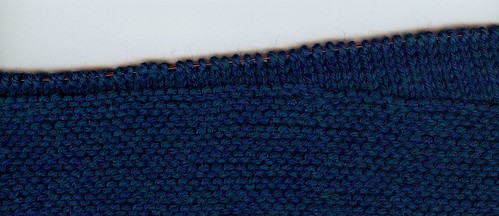We had a couple of questions about our Baby Cables project. Alison asked about the position of our short row shaping, and Deirdre wanted to know more about the neck sizing. Here goes!
First, why did we add short rows — the pattern does not call for them and the sweater looks great, so why bother? When trying on the yoke during construction, the back neck clearly wanted to ride at least an inch higher than the front. We were concerned that this would cause the sweater to pull up in back. Short rows in a top down sweater need to be added before the split is made for the sleeves to add length to the back neck — adding short rows after the break for the sleeves will add length to the back body. We wanted to complete the garter stitch section before doing the short rows so they would not disrupt the ridges.
This diagram shows the placement of the short row turns. We used Japanese Short Rows, which are described very well by NonaKnits.

And here are Susan’s short rows:

Deirdre asked about the size of the neck opening. It is relatively large – and somewhat like a boatneck fit. Susan made hers smaller relative to the size of the pattern by casting on the smallest number of sts and then adjusting the increases accordingly. Some people like the openness of the neck and would not need to adjust. By casting on in increments of 8 sts, you can adjust the neck opening as desired as long as you account for the difference in your increases.
From Susan: I did not get as far as I wanted to yesterday and today looks unlikely as well! Bummer, but chores and holiday activities are cutting into my knitting time!
From Sally: I am doing some stealth holiday knitting, but still hope to get the second sleeve finished in the next few days.
ETA: Jane asked about our doing short rows on the front. Just to clarify, the short rows are adding length to the back. The “x”s on the front show where the short rows ended — where the turns occur. The short rows are knit completely across the back but only partway across the front as indicated. We hope the revised diagram is more helpful and descriptive. Obviously, it only makes sense when you are working from the pattern.

















Thanks for the tips. I bought that pattern and look forward to knitting it (someday); I will profit by your experience.
Comment by kmkat — December 7, 2008 @ 6:51 pm
Wow. I’ve never added short rows to the front of a garment. I often add them to the back. I would have guessed short rowing in the front would add a bulge (like bust shaping). Did these nudge up the front to match the back of the neckline? Love your tips. Jane
Comment by JaneOC — December 7, 2008 @ 9:05 pm
Thanks! I love the posts where you guys talk about how you have modified patterns and what techniques you prefer. I have learned so much from this blog!
Comment by Natalie — December 8, 2008 @ 2:37 pm
Thanks! this is very helpful and after looking at your diagram I understand the purpose, concept, and anticipated result perfectly: the short rows wrap around the shoulders and add extra fabric over the shoulders and across the back, thereby lowering the front! I get it! what a great idea! Thank you so much for sharing this information.
Comment by Linda M — December 8, 2008 @ 3:35 pm
Short rows are the bomb! Nice use of them here.
Comment by Valerie — December 8, 2008 @ 10:24 pm
Everything makes perfect sense now. My brain must have been taking a nap! Thanks for all the valuable information.
Comment by Jane — December 10, 2008 @ 9:00 am
Thank you so much for your tips – I love the way you sweater is looking, and can’t wait to start mine!
Comment by Deirdre — December 12, 2008 @ 3:48 pm
Hi! I’d love to see this diagram on short rows, but unfortunately the pictures are unavailable…
Comment by Malin — October 26, 2009 @ 1:53 pm